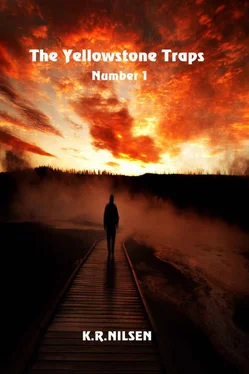“Abel.”
“Yes.”
“Ah, the cabinet bunks of yours, upstairs….”
“Yes.”
“Could I, could I see them?”
Volcano Threat Prompts Yellowstone Park Evacuation
By Jonathan Bellingham, contributing science editor
The New York Times
CHEYENNE, WYOMING– U.S. Geological Survey scientists at the Yellowstone Volcano Observatory issued a volcano advisory at 9:15 a.m. MT for Yellowstone National Park, prompting officials to order the evacuation of nonessential personnel from the nation’s largest park and nearby communities.
According to Yellowstone Volcano Observatory Supervising Geologist Wesley Crouch, increasing seismic activity, accelerating thermal outflow at the surface, changes in gas and water chemistry and rapid uplift of broad regions of the parklands signal the potential for future volcanic activity within the park.
The official statement read, ‘Deteriorating surface conditions within Yellowstone have rendered much of the parkland unsuitable for recreation at this time. Rising ground and water temperatures in many areas have forced the closure of most of the geyser basins and park villages. The threat of hydrothermal explosions due to increasing steam pressure within the rock strata is elevated.
‘Of particular concern,’ the document continued, ‘is the escalating incidence of low-frequency seismic signals, known as harmonic tremors, long associated with the movement of magma beneath the world’s active volcanoes.’ At Yellowstone, there are no known active volcanic vents at the surface and the tremors are not confined to a single area within the park.
Scientists are concerned about the potential for eruption at Yellowstone because of the dramatic geological history of the caldera and volcanic hot spot that underlies the park. It is well known among geologists and vulcanologists that Yellowstone periodically erupts, on occasion with catastrophic force. Some twenty or so eruptive events have occurred over the past 15 million years in the Yellowstone region and west along the Snake River Valley.
Yellowstone National Park lies within the boundaries of Wyoming, Idaho and Montana. Wyoming Governor Randall Seifert is reportedly upset with USGS officials over the issuance of the volcano advisory. He could not be reached for comment, but an aide to the governor said he would be calling on the governors of the Mountain states with the intention of having the advisory killed.
A volcano advisory is the first part of a two-stage warning system designed to inform and protect the public. An advisory is a general warning indicating that volcanic activity is possible within the coming days, weeks, or months. It may or may not be accompanied by a general evacuation order. The second stage, a volcano alert, indicates that a volcanic eruption is imminent and full measures must be taken to insure that all citizens are evacuated from the hazard zone, including the evacuation of residents who reside in river and stream valleys subject to dangerous volcano-spawned mud flows known as lahars.
At the edge of a picnic area parking lot at Norris Geyser Basin, a young couple sleeping in the bed of their Dodge Ram 4x4 pickup truck awoke suddenly just after 5 a.m. The illegally-parked vehicle was creaking, rocking on its springs. In the gray light of a late-April dawn, the roar of a jet engine sliced through the thin metal skin of the cap. Terrified, the young man and woman scrambled from the pickup bed, scurried into the cab and raced away north on the loop road toward Mammoth Hot Springs.
Steamboat geyser awoke violently from a decade-long slumber. The tallest, most majestic geyser on the planet, Steamboat exploded from its confines, shearing away rock shards that pelted the boardwalks and trails. Majestic jets of water thrust up and fell in rapid succession. As the turbulent liquid cleared the throat of the thermal marvel, pressure dropped in the creature’s gut, permitting superheated water below to flash to steam. Steamboat launched a river of water and jets of volatile vapor high above the basin, topping out at nearly 400 feet.
On the flank of the Roaring Mountain five miles north of Norris Geyser Basin, a Park Service employee was out early to inspect Yellowstone’s roads for winter frost, wave and earthquake damage, now that most of the park’s miles of highway were free of their winter burden of ice and snow. Crossing the flank of the low peak, the man slowed his truck and stopped before a sprawling fumarole field peppering the ridge’s slopes. Named in the late 1800s for the upland’s continuous loud steam rumbling, Roaring Mountain quieted down to a hush over the decades of the 20th century. Now, howling screams from the earth prompted the Park Service driver to apply the brakes. He rolled down a window and glared at the throbbing ridgeline. A minor thermal feature in the park, Roaring Mountain was now seething, billowing moist smoke. It seemed to the driver, who rarely gave the steam fields a glance, that the entire mountain was ablaze with thick smoke from unseen fires.
The weekend was fast approaching. The Geological Survey staff, graduate students and researchers, spellbound by and yet weary of poring over the seismic data flooding in from the seismic array, tilt meters, GPS recorders and other field instruments across Yellowstone, wanted to get away.
Liz longed for May to arrive, when she could finally catch her flight from Bozeman and fly off eastbound to see her daughter. She had been away for nearly ninety days over the last six months and was punch-drunk from the long hours of work. She needed to bid Yellowstone goodbye.
Still, there were four long days ahead of her. Although she felt like King Sisyphus, condemned to roll a boulder uphill in Hades for eternity, these were heady times at Yellowstone National Park. The beast was disgruntled, now wildly unpredictable, and monitoring its vital signs was intoxicating.
Throughout the month of April, Yellowstone beckoned the scientific community with a siren song of continuous tremors. Harmonic disturbances rattled park headquarters offices and soon-to-reopen village stores, campgrounds and inns. For the first time since the dawn of the millennium, when the Park Service closed many of the foot trails in Norris Geyser Basin because of ground temperatures as hot as boiling water, there was talk in the offices and down the halls about closing great stretches of terrain in the park for the tourist season, and not just the heavily damaged Bridge Bay marina compound and shattered Lake Village.
Every day brought new surface anomalies. The dormant spigots at largely forgotten Monument Geyser Basin were howling for the first time anyone could remember.
At Hell’s Half Acre along the Firehole River, sprawling Excelsior geyser blew out rocks and sinter debris from its football field-size crater and roared to a spectacular 300-foot eruption, the likes of which had not been recorded since the Hayden exploratory expedition took blurry tintype photographs thirteen decades in the past.
Away to the southwest, Fishing Cone, perched low in the water at the very edge of the shoreline, was unapproachable. Where anglers once caught fish in the lake and cooked them in a minute by dangling them into the little maw of the hot spring, violent, spasmodic jets of boiling water spiraled into the atmosphere.
The flooded realm beneath Yellowstone Lake was not at peace, either. Liz and her colleagues were now convinced that magma was upwelling, invading strata very close to the floor of the lake. All her probes, from West Thumb basin to Elk Point, were registering extraordinary heat levels. Data left no doubt that the lake bottom basins were bleeding torrents of superheated water into the depths. As troubling to researchers and Park officials as the surface thermal features was the propagation of miles of concentric ring fractures snaking through the landscape and slowly defining a vast convoluted oval shape nearly seventy miles across. Geologists, park employees and backcountry hikers stumbled upon the fractures with greater and greater frequency, yet it was only in the last few months that the true extent of them became known.
Читать дальше










